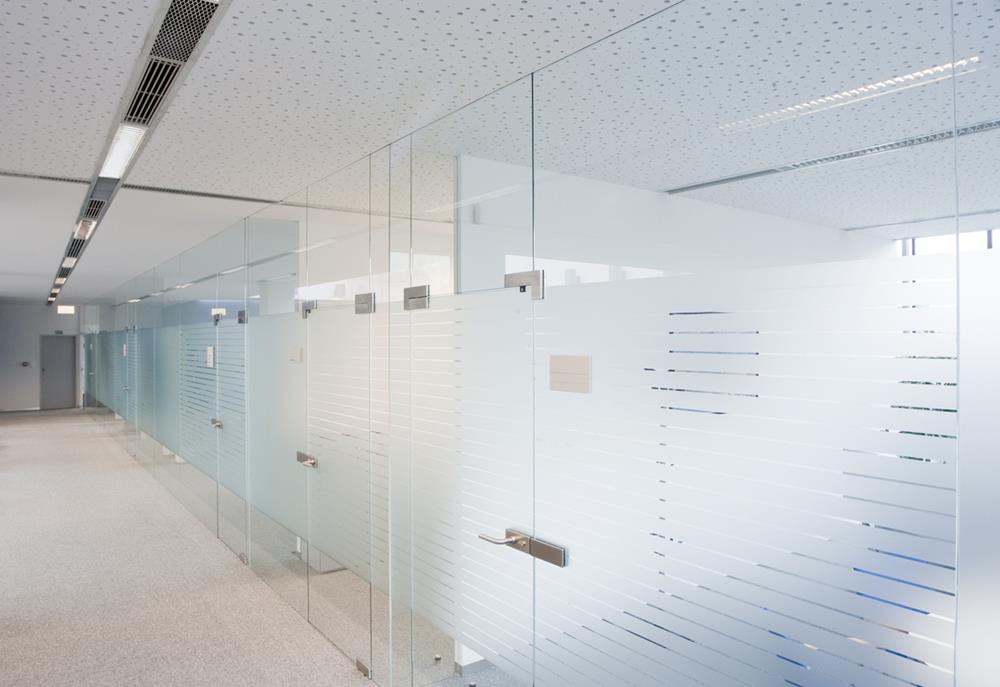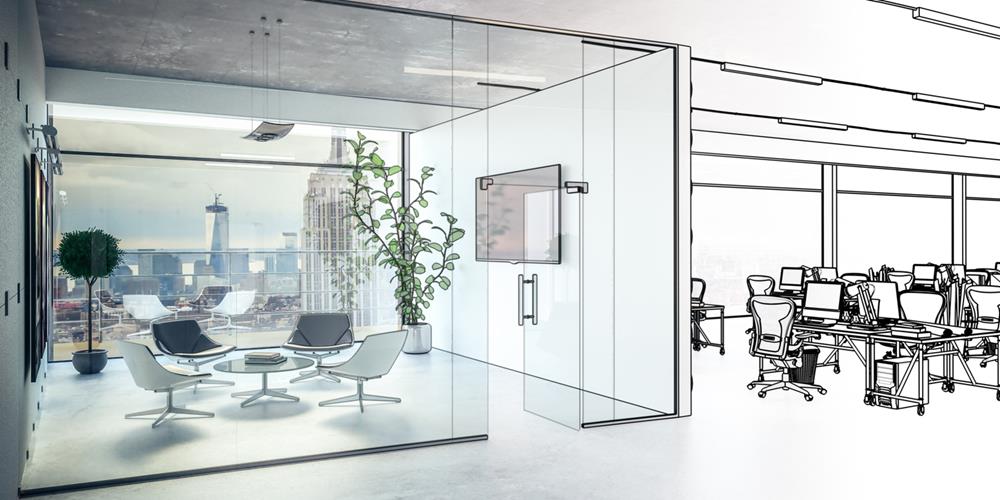The modern interior design landscape is constantly evolving, breaking through traditional boundaries to embrace openness and light. Glass partitions have emerged as a beacon of aesthetic freedom in this dynamic environment, transforming how spaces are defined within homes, offices, and commercial areas.
By blending functionality with sleek design, these transparent barriers offer an innovative solution to spatial challenges, inviting natural light to flow freely and fostering a sense of connectedness. This article dives into the world of glass partitions, showcasing how they revolutionize interior spaces by marrying practicality with unparalleled style.
What are Glass Partitions?
Glass partitions are innovative architectural elements that serve to divide spaces without the weight and opacity of traditional walls. Made from sheets of glass secured in frames, these partitions can be either fixed or movable, providing flexibility and functionality in layout design. They come in various forms, including frosted, clear, colored, or patterned glass, allowing for customization according to privacy needs and aesthetic preferences.
Glass partitions have become increasingly popular in both residential and commercial settings. In homes, they can separate living areas, create home offices, or enclose sunrooms, all while maintaining an open feel and maximizing natural light. In offices and commercial spaces, they offer a modern look, improve acoustics, and facilitate a collaborative environment by breaking down visual barriers while still delineating functional zones.
The Benefits of Glass Partitions
Glass partitions are not just a design statement; they offer a myriad of benefits that enhance both the functionality and aesthetics of any space. From fostering a collaborative work environment to maximizing natural light, the advantages of incorporating glass partitions into a design are manifold. Here, we delve into some of the key benefits that make glass partitions a popular choice among architects and interior designers.
Enhanced Natural Light
One of the most significant advantages of glass partitions is their ability to allow natural light to permeate through spaces. This not only reduces the reliance on artificial lighting, leading to energy savings but also creates a more welcoming and productive environment. Natural light has been shown to boost mood and productivity, making glass partitions an excellent choice for office spaces where maximizing employee well-being is a priority.
Illusion of More Space
Glass partitions contribute to a sense of openness, making spaces appear larger than they are. Unlike solid walls, which can make areas feel cramped and closed off, glass partitions maintain visual continuity across spaces. This feature is particularly beneficial in smaller offices or homes, where maximizing the perception of space is crucial for comfort and functionality.
Modern Aesthetics
Incorporating glass partitions into a space instantly gives it a modern, sophisticated look. The clean lines and transparent nature of glass add a touch of elegance and minimalism that is highly sought after in contemporary design. Whether used in a residential setting or a commercial environment, glass partitions elevate the overall aesthetic, making a space look more refined and thoughtfully designed.
Improved Acoustics
Contrary to what one might assume, glass partitions can significantly improve the acoustics of a space. Special acoustic glass options are available that can help dampen sound, making them an ideal choice for busy offices or homes located in noisy environments. By reducing noise pollution, glass partitions contribute to a more peaceful and productive atmosphere.
Flexibility and Customization
Glass partitions offer unparalleled flexibility in design and can be customized to fit the specific needs of a space. They can be installed as permanent fixtures or designed as movable walls that can be reconfigured as needs change. Additionally, glass partitions come in various finishes and styles, from frosted to colored glass, allowing for privacy without sacrificing natural light.
Encourages Collaboration
In office settings, glass partitions facilitate a sense of openness and connectivity among employees. By breaking down physical barriers, they encourage communication and collaboration, fostering a more dynamic and interactive work environment. This transparency can also contribute to a culture of trust and inclusivity within an organization.
Installing Glass Partitions
Installing glass partitions is a strategic way to redefine your space, whether it’s for creating a home office, dividing a room, or enhancing a commercial area. The process involves careful planning and precision to ensure safety and achieve the desired aesthetic. Here’s a step-by-step guide on how to install glass partitions effectively.
Initial Planning
The first step involves thorough planning, which includes deciding on the partition’s location, size, and purpose. Consider how the partition will interact with existing architectural elements and how it will affect the flow of natural light. Measurements need to be accurate to ensure the glass fits perfectly without any gaps. This stage may also involve consulting with a designer or architect to ensure the partition meets both aesthetic and functional needs.
Choosing the Right Type of Glass
Selecting the appropriate type of glass is crucial for both safety and functionality. Options include tempered glass, which is stronger and safer than regular glass, and laminated glass, which holds together when shattered. The choice may depend on the partition’s location and the level of privacy required. Frosted or tinted glass can provide privacy while still allowing light to pass through.
Preparing the Area
Before installation begins, prepare the area where the partition will be installed. This may involve clearing furniture, removing existing fixtures, and ensuring the floor is level. The area must be clean to prevent any debris from affecting the installation. It’s also essential to check for any wiring or plumbing in the installation area to avoid damage.
Installing the Frame
The next step is to install the frame that will hold the glass partition. The frame needs to be securely attached to the floor, ceiling, and adjacent walls to provide adequate support. Precision is key during this phase to ensure the frame is perfectly level and plumb. Depending on the design, the frame may be made of metal, wood, or another material that complements the interior design.
Placing the Glass
With the frame securely in place, the glass can be carefully installed. This step requires at least two people to safely maneuver the glass into position without causing damage or injury. The glass is secured within the frame using specialized clips or gaskets that hold it firmly while allowing for slight movements, which is necessary to accommodate temperature changes and prevent cracking.
Sealing and Finishing Touches
The final step involves sealing the edges of the glass to prevent drafts and enhance soundproofing. Silicone sealant or rubber gaskets are typically used for this purpose. Once the sealant is dry, clean the glass thoroughly to remove any fingerprints or smudges. Now is also the time to add any additional features, such as door handles or blinds, to complete the installation.
Interesting Facts About Glass Partitions
Glass partitions, beyond their sleek appearance and practical utility, are surrounded by fascinating facts and figures that highlight their growing popularity and innovative applications. As these transparent barriers become a staple in modern architecture and interior design, let’s explore some of the lesser-known aspects that contribute to their appeal.
- Energy Efficiency: Glass partitions can significantly reduce a building’s energy consumption. By allowing natural light to permeate deeper into the interior, they reduce the need for artificial lighting during the day. Studies have shown that buildings utilizing glass partitions can save up to 10% on their energy bills, contributing to both environmental sustainability and cost savings.
- Sound Insulation: While glass is often perceived as a poor insulator of sound, advancements in technology have led to the development of acoustic glass partitions. These specialized partitions can achieve sound insulation levels comparable to solid walls, with ratings up to 50 decibels, making them an excellent choice for offices and homes alike.
- Durability and Safety: Modern glass partitions are made from tempered or laminated glass, which is up to five times stronger than regular glass. In the unlikely event of breakage, tempered glass shatters into small, blunt pieces, significantly reducing the risk of injury. Laminated glass, on the other hand, remains intact even when broken, thanks to a protective interlayer.
- Market Growth: The global market for glass partitions is on a steady rise, driven by the demand for more flexible and aesthetically pleasing workspaces. The market is expected to continue growing, with projections suggesting a compound annual growth rate of over 7% from 2020 to 2026.
- Recyclability: Glass is 100% recyclable without loss in quality or purity. Glass partitions contribute to the sustainability of a building since they can be fully recycled at the end of their lifecycle, reducing waste and conserving resources.
- Health Benefits: Studies have found that workspaces with ample natural light and open views, as facilitated by glass partitions, can improve workers’ health and well-being. Employees in such environments report higher levels of satisfaction, lower stress levels, and improved mental health.
- Customization and Art: Glass partitions offer vast opportunities for customization through etching, frosting, and printing. They can be transformed into works of art, displaying company logos, artistic designs, or privacy patterns, adding a unique character to any space.
Conclusion
Through their ability to blend functionality with aesthetic appeal, these glass partitions carved a niche for themselves in the realms of modern architecture and interior design. Whether it’s enhancing the flow of natural light, creating the illusion of a more expansive area, or promoting a collaborative atmosphere, glass partitions offer a myriad of benefits that go beyond mere aesthetics.
Additional Suggestions
- The use of glass partition walls has been popular in corporate settings in recent years, and its popularity for residential spaces is slowly growing.


